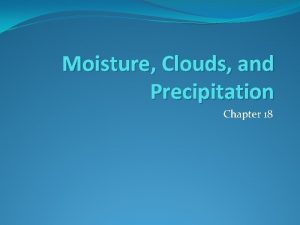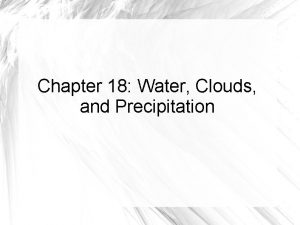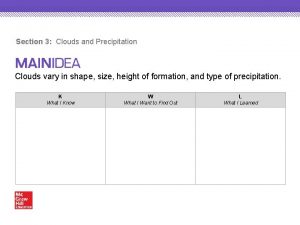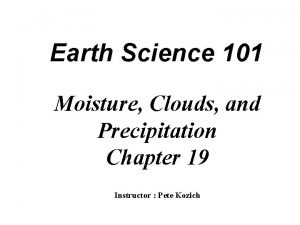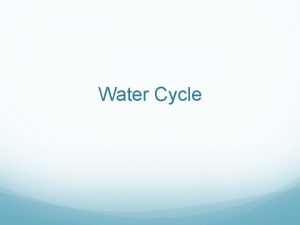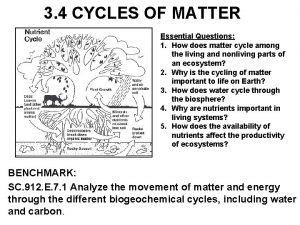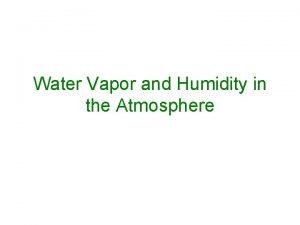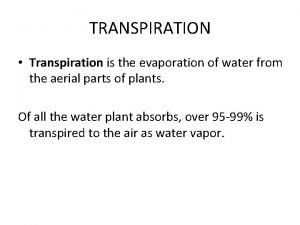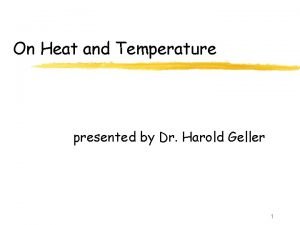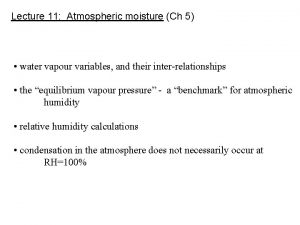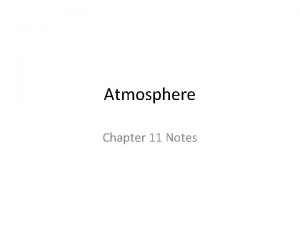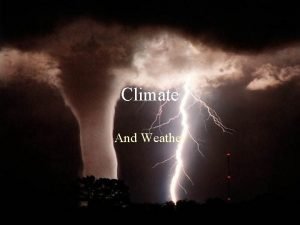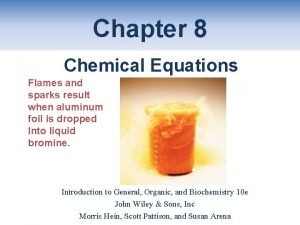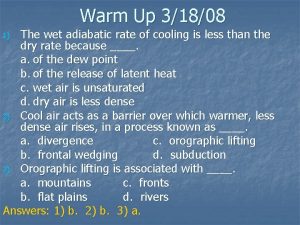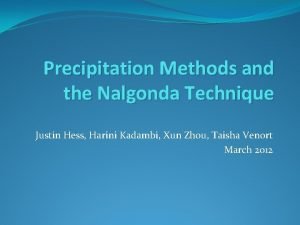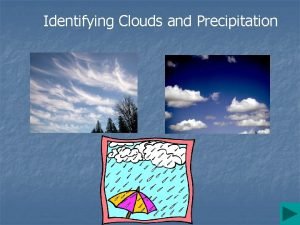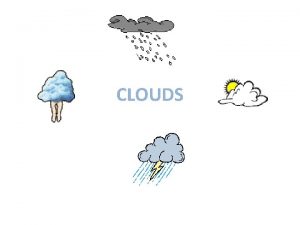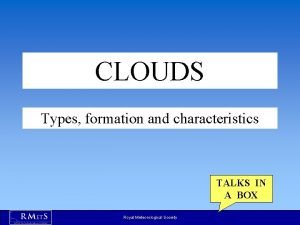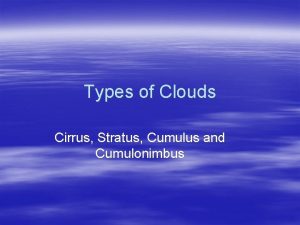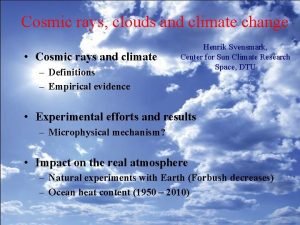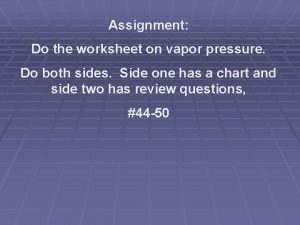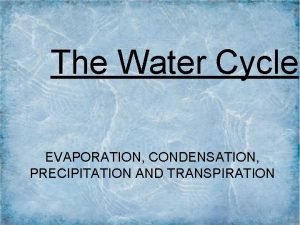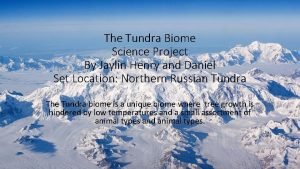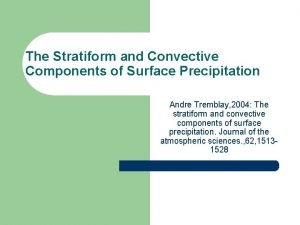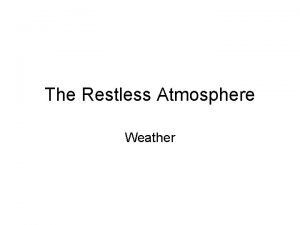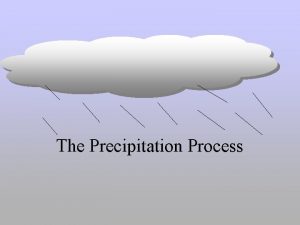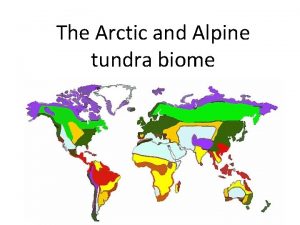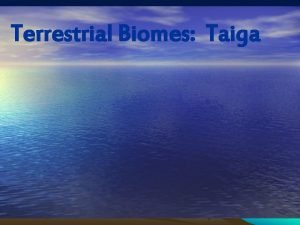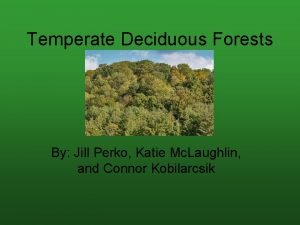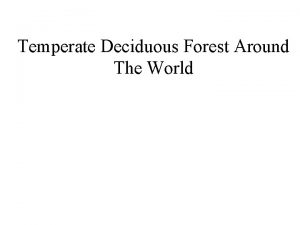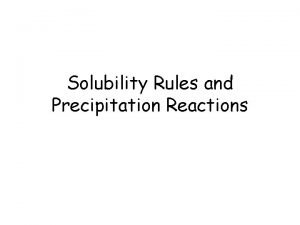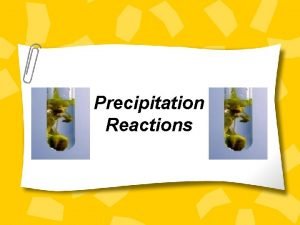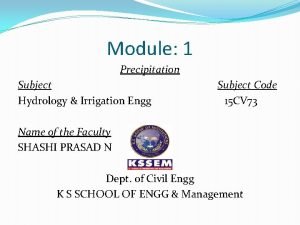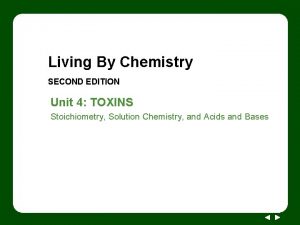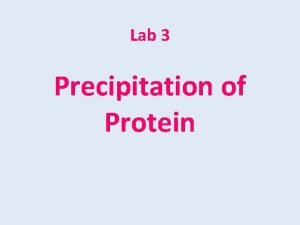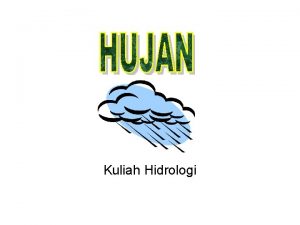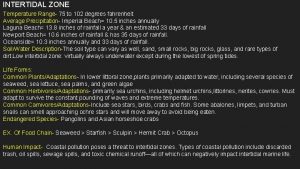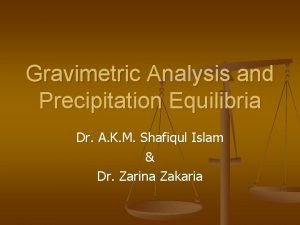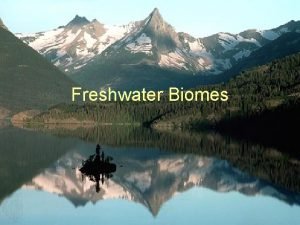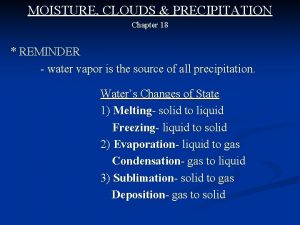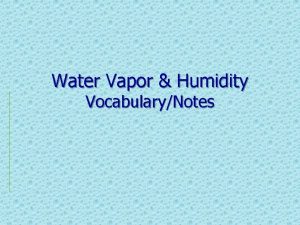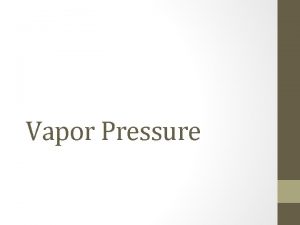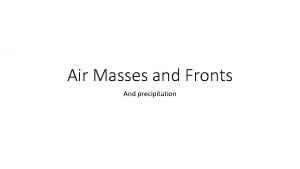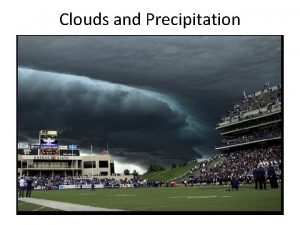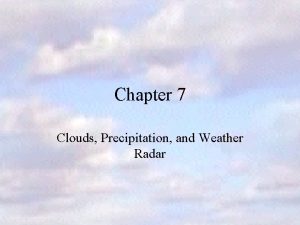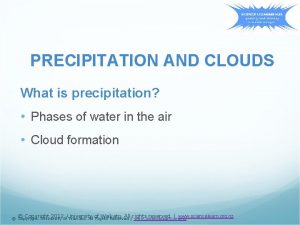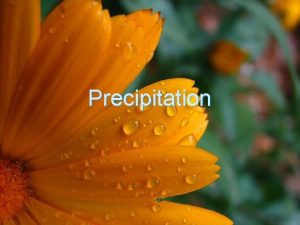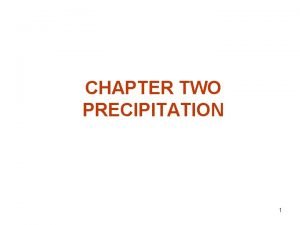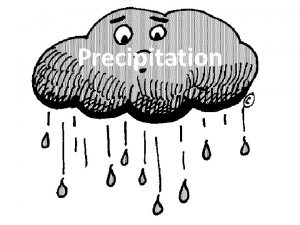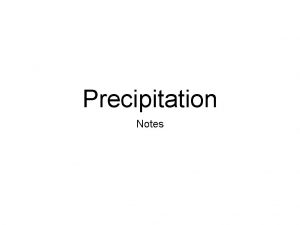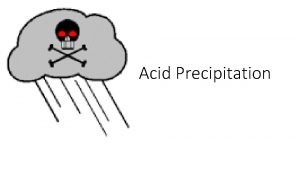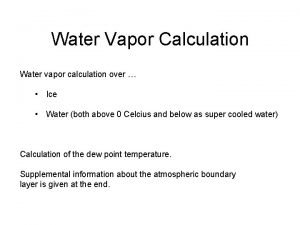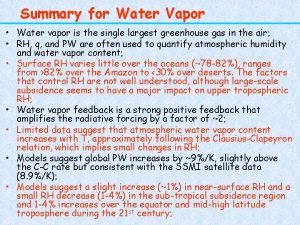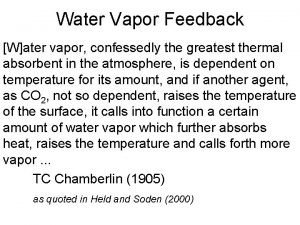Water Vapor Clouds and Precipitation Water vapor in






























































- Slides: 62

Water Vapor, Clouds, and Precipitation Water vapor in the air Saturation and nucleation of droplets Cloud formation and moist convection Droplet growth and raindrops Mixed phase clouds (vapor, droplets, and ice)

Molecular Structure of Water water molecule ice Water's unique molecular structure and hydrogen bonds enable all 3 phases to exist in earth's atmosphere. Sublimation & deposition describe the non-incremental changes between solid and vapor phases.

Energy associated with phase change Sublimation Deposition

Why does it take so much energy to evaporate water? • In the liquid state, adjacent water molecules attract one another – “-” charge on O attracted to “+” charge on H – we call this hydrogen bonding • This same hydrogen bond accounts for surface tension on a free water surface – column of water “sticks together”

Sublimation – evaporate ice directly to water vapor Take one gram of ice at zero degrees centigrade Energy required to change the phase of one gram of ice to vapor: Add 80 calories to melt the ice Add 100 calories to raise the temperature to 100 degrees C Add 540 calories to evaporate the liquid Total Energy ADDED for sublimation of 1 gram of ice: 80 + 100 + 540 = 720 calories

Deposition – convert vapor directly to ice Take one gram of water vapor at 100 degrees Centigrade Release 540 calories to condense Release 100 calories to cool temperature of liquid to o. C Release 80 calories to freeze water Total energy RELEASED for deposition of 1 gram of ice 540 + 100 + 80 = 720 calories

Water vapor pressure • Molecules in an air parcel all contribute to pressure • Each subset of molecules (e. g. , N 2, O 2, H 2 O) exerts a partial pressure • The VAPOR PRESSURE, e, is the pressure exerted by water vapor molecules in the air – similar to atmospheric pressure, but due only to the water vapor molecules – often expressed in mbar (2 -30 mbar common at surface)

Water vapor saturation • Water molecules move between the liquid and gas phases • When the rate of water molecules entering the liquid equals the rate leaving the liquid, we have equilibrium – The air is said to be saturated with water vapor at this point – Equilibrium does not mean no exchange occurs

Relationship between e. S and T • The saturation vapor pressure of water increases with temperature – At higher T, faster water molecules in liquid escape more frequently causing equilibrium water vapor concentration to rise – We sometimes say “warmer air can hold more water” • There is also a vapor pressure of water over an ice surface – The saturation vapor pressure above solid ice is less than above liquid water

e. S vs T schematic Saturation vapor pressure depends only upon temperature

How do we express the amount of water vapor in an air parcel? • Absolute humidity – mass of water vapor/volume of air (g/m 3) – changes when air parcel volume changes • Specific humidity – mass of water vapor/mass of air (g/kg) • Mixing ratio – mass of water vapor/mass of dry air (g/kg) • Specific humidity and mixing ratio remain constant as long as water vapor is not added/removed to/from air parcel • Dew point temperature

Expressing the water vapor pressure • Relative Humidity (RH) is ratio of actual vapor pressure to saturation vapor pressure – 100 * e/e. S – Range: 0 -100% (+) – Air with RH > 100% is supersaturated • RH can be changed by – Changes in water vapor content, e – Changes in temperature, which alter e. S

Dewpoint Temperatures • Dewpoint is a measure of the water vapor content of the air • It is not a measure of temperature!

Which environment has higher water vapor content?

Why is the southwest coast of the US hot and dry while the Gulf coast is hot and moist? • Both are adjacent to large bodies of water • Both experience onshore wind flow on a regular basis • Why does one have a desert like climate and the other ample moisture and rainfall?

Humidity reflects water temps The cold water temperatures typically found off the west coast of continents are a result of oceanic upwelling which ocean currents typically cause in these locations

Water vapor is distributed throughout the atmosphere • Generally largest amounts are found close to the surface, decreasing aloft – Closest to the source - evaporation from ground, plants, lakes and ocean – Warmer air can hold more water vapor than colder air




Condensation • Condensation is the phase transformation of water vapor to liquid water • Water does not easily condense without a surface present – Vegetation, soil, buildings provide surface for dew and frost formation – Particles act as sites for cloud and fog drop formation

Dew • Surfaces cool strongly at night by radiative cooling – Strongest on clear, calm nights • The dew point is the temperature at which the air is saturated with water vapor • If a surface cools below the dew point, water condenses on the surface and dew drops are formed • Dew does not “fall”

Frost • If the temperature is below freezing, the dew point is called the frost point • If the surface temperature falls below the frost point water vapor is deposited directly as ice crystals – deposition • The resulting crystals are known as frost, hoarfrost, or white frost

Cloud and fog drop formation • If the air temperature cools below the dew point (RH > 100%), water vapor will tend to condense and form cloud/fog drops • Drop formation occurs on particles known as cloud condensation nuclei (CCN) • The most effective CCN are water soluble. • Without particles clouds would not form in the atmosphere – RH of several hundred percent required for pure water drop formation

Typical Sizes

Very Small Drops Tend to Evaporate! • Surface of small drops are strongly curved • Stronger curvature produces a higher esat • Very high RH required for equilibrium with small drops – ~300% RH for a 0. 1 µm pure water drop If small drops evaporate, how can we ever get large drops? !

Homogeneous Nucleation • Formation of a pure water drop without a condensation nucleus is termed “homogeneous nucleation” • Random collision of water vapor molecules can form a small drop embryo – Collision likelihood limits maximum embryo size to < 0. 01 µm • esat for embryo is several hundred percent – Embryo evaporates since environmental RH < 100. 5%

The Solute Effect • Condensation of water on soluble CCN dissolves particle – Water actually condenses on many atmospheric salt particles at RH ~70% • Some solute particles will be present at drop surface – Displace water molecules – Reduce likelihood of water molecules escaping to vapor – Reduce esat from value for pure water drop Water molecule Solute molecule

Steps in Cloud/Fog Formation • Air parcel cools causing RH to increase – Radiative cooling at surface (fog) – Expansion in rising parcel (cloud) • CCN (tenths of µm) take up water vapor as RH increases – Depends on particle size and composition • IF RH exceeds critical value, drops are activated and grow readily into cloud drops (10’s of µm)

Where do CCN come from? • • Not all atmospheric particles are cloud condensation nuclei (CCN) Good CCN are hygroscopic (“like” water, in a chemical sense) Many hygroscopic salt and acid particles are found in the atmosphere Natural CCN • CCN from human activity – Sea salt particles (Na. Cl) – Particles produced from biogenic sulfur emissions – Products of vegetation burning – Pollutants from fossil fuel combustion react in the atmosphere to form acids and salts – Sulfur dioxide reacts to form particulate sulfuric acid and ammonium sulfate salts – Nitrogen oxides react to form gaseous nitric acid which can combine with ammonia to form ammonium nitrate particles

Cloud development • Clouds form as air rises, expands and cools • Most clouds form by – Surface heating and free convection – Lifting of air over topography – Widespread air lifting due to surface convergence – Lifting along weather fronts

Fair weather cumulus cloud development • • • Air rises due to surface heating RH rises as rising parcel cools Cloud forms at RH ~ 100% Rising is strongly suppressed at base of subsidence inversion produced from sinking motion associated with high pressure system Sinking air is found between cloud elements

Fair weather cumulus cloud development schematic

What conditions support taller cumulus development ? • A less stable atmospheric (steeper lapse rate) profile permits greater vertical motion • Lots of low-level moisture permits latent heating to warm parcel, accelerating it upward

Determining convective cloud top • Cloud top is defined by the upper limit to air parcel rise • The area between the dry/moist adiabatic lapse rate, showing an air parcel’s temperature during ascent, and the environmental lapse rate, can be divided into two parts – A positive acceleration part where the parcel is warmer than the environment – A negative acceleration part where the parcel is colder than the environment • The approximate cloud top height will be that altitude where the negative acceleration area is equal to the positive acceleration area


Orographic clouds • Forced lifting along a topographic barrier causes air parcel expansion and cooling • Clouds and precipitation often develop on upwind side of obstacle • Air dries further during descent on downwind side

Lenticular clouds • • Stable air flowing over a mountain range often forms a series of waves – Think of water waves formed downstream of a submerged boulder Air cools during rising portion of wave and warms during descent Clouds form near peaks of waves A large swirling eddy forms beneath the lee wave cloud – Observed in formation of rotor cloud – Very dangerous for aircraft

Cumulus Clouds & Clear Sky Figure 7. 15

Cumulus to Cumulonimbus Figure 7. 18


Convective clouds • As seen from space, convective clouds are quite shallow … why?

Changing cloud forms • Differential heating/cooling of top and bottom of a continuous cloud layer can cause it to break up into smaller cloud elements – Cloud top absorbs solar radiation but cools more quickly by radiative cooling – Bottom of cloud warms by net absorption of IR radiation from below – The result is that the layer within the cloud becomes less stable and convection may ensue

Cloud Classification • Clouds are categorized by their height, appearance and vertical development – High Clouds - generally above 16, 000 ft at middle latitudes • Main types - Cirrus, Cirrostratus, Cirrocumulus – Middle Clouds – 7, 000 -23, 000 feet • Main types – Altostratus, Altocumulus – Low Clouds - below 7, 000 ft • Main types – Stratus, stratocumulus, nimbostratus – Vertically “developed” clouds (via convection) • Main types – Cumulus, Cumulonimbus

Cloud type summary

Cirrus

Stratiform cloud layers

Precipitation Formation • How does precipitation form from tiny cloud drops? – Warm rain process – The Bergeron (ice crystal) process • Most important at mid and northern latitudes How many 20 µm cloud drops does it take to make a 2000 µm rain drop? V = pd 3/6

Rain formation in warm (not frozen) clouds • • • In a supersaturated environment, activated cloud drops grow by water vapor condensation – It takes many hours for the cloud drop to approach rain drop size Collisions between cloud drops can produce large rain drops much faster through coalescence – Collisions occur in part due to different settling rates of large and small drops – Not all collisions result in coalescence Rain formation favored by – Wide range of drop sizes – Thick cloud – Fast updrafts

Rain formation in warm clouds - II • Capture of a cloud/rain drop in a cloud updraft can give it more time to grow – The drop falls at a fixed speed relative to the air, not the ground – Large drops fall faster

Rain drop size and shape • Drizzle drops – 100’s of µm • Rain drops – a few millimeters – Rain drops larger than 5 mm tend to break up • When colliding with other drops • From internal oscillations • Rain drops have shapes ranging from spherical (small drops) to flattened spheroids (large drops) – In large drops surface tension is no longer strong enough to overcome flattening of falling drop due to pressure effects

Precipitation and the ice crystal process • At mid and northern latitudes most precipitation is formed via ice crystal growth • Supercooled cloud drops and ice crystals coexist for – 40º < T < 0º C – Lack of freezing nuclei to glaciate drops • Ice crystals can grow by – Water vapor deposition – Capture of cloud drops (accretion/riming) – Aggregation

Ice crystals and ice nuclei • • • Thin Plates Ice crystal shapes depend on the environmental – Temperature – Water vapor concentration Hollow Columns Needles Ice crystal formation usually involves ice nuclei Ice nuclei – Are much less common than cloud condensation nuclei – Include some clay mineral particles, bacteria, plant leaf detritus and ? ? – Freezing nuclei initiate the freezing of water droplets between temperatures of 0ºC and -40ºC – Artificial ice nuclei, used for cloud seeding, include dry ice and silver iodide Dendrites Sector Plates Hollow Columns

Ice crystal growth by vapor deposition (Bergeron process) • Ice binds water molecules more tightly than liquid water – For temperatures less than 0ºC, the saturation vapor pressure over ice is LESS than the saturation vapor pressure over super-cooled water • This leads to evaporation of water from supercooled cloud drops and deposition onto ice crystals

Water vapor saturation vs T

Ice crystal growth by accretion • Ice crystals fall faster than cloud drops • Crystal/drop collisions allow ice crystals to capture cloud drops – The supercooled drops freeze upon contact with the ice crystal – This process is known as accretion or riming • Extreme crystal riming leads to the formation of – Graupel – Hail

Ice crystal growth by aggregation • Crystal/crystal collisions can lead to formation of crystal aggregates – Crystals most likely to stick when a liquid water layer resides on the crystal surface • Watch for large aggregates/snowflakes when temperatures are close to 0º C

Precipitation in cold clouds • Low liquid water content promotes diffusion/deposition growth of large crystals • High liquid water content promotes riming and formation of graupel/hail • If the sub-cloud layer is warm, snow or graupel may melt into raindrops before reaching the surface (typical process for summer rain in Colorado)

Precipitation types • Rain that evaporates before reaching the surface is termed virga – Common in Colorado’s dry climate • Precipitation reaching the surface can take on different forms depending on the vertical temperature profile

Hail • Hail can form in clouds with – High supercooled liquid water content – Very strong updrafts • Hailstones associated with deep and intense cumulonimbus – Typically make 2 -3 trips up through cloud • Opaque and clear ice layers form – Opaque represents rapid freezing of accreted drops – Clear represents slower freezing during higher water accretion rates – Layering tells about hailstone history The largest hailstone ever recovered in the United States, a seven -inch (17. 8 centimeter) wide chunk of ice almost as large as a soccer ball. It was found in Aurora, Nebraska on June 22, 2003. The hailstone lost nearly half of its mass upon landing on the rain gutter of a house


Thunderstorm life cycle Cumulus stage Mature stage Dissipating stage
 Co precipitation and post precipitation
Co precipitation and post precipitation Co precipitation and post precipitation
Co precipitation and post precipitation Air that resists vertical movement is said to be
Air that resists vertical movement is said to be Love of cloud and rain chapter 18
Love of cloud and rain chapter 18 Section 3 clouds and precipitation
Section 3 clouds and precipitation Moisture clouds and precipitation
Moisture clouds and precipitation Nr-13
Nr-13 Water and water and water water
Water and water and water water Surface runoff meaning
Surface runoff meaning Precipitation in the water cycle
Precipitation in the water cycle Water vapour formula
Water vapour formula Diffusion shells transpiration
Diffusion shells transpiration The capacity of air to hold water vapor
The capacity of air to hold water vapor Water vapour formula
Water vapour formula Water vapor in the atmosphere percentage
Water vapor in the atmosphere percentage Water vapor mixing ratio
Water vapor mixing ratio Raoult's law for non volatile solute
Raoult's law for non volatile solute Highest clouds
Highest clouds Chemical reaction of phosphorus
Chemical reaction of phosphorus To beat rapidly to incorporate air and increase volume.
To beat rapidly to incorporate air and increase volume. Compare and contrast clouds and fogs.
Compare and contrast clouds and fogs. Nalgonda technique steps
Nalgonda technique steps Every complete sentence contains two parts a subject and a
Every complete sentence contains two parts a subject and a Identifying cloud types
Identifying cloud types Types of cloud cover
Types of cloud cover O when the moon is not quite round
O when the moon is not quite round Characteristics of clouds
Characteristics of clouds Stratus cumulus cirrus
Stratus cumulus cirrus Cosmic rays and clouds
Cosmic rays and clouds Low-lying clouds that produce rain and snow
Low-lying clouds that produce rain and snow Vapor pressure and boiling worksheet answers
Vapor pressure and boiling worksheet answers Intermolecular forces and vapor pressure
Intermolecular forces and vapor pressure Ammonium sulfate precipitation
Ammonium sulfate precipitation Transpiration
Transpiration Bearberry adaptations
Bearberry adaptations Taiga climate temperature
Taiga climate temperature Stratiform precipitation
Stratiform precipitation Relief rain
Relief rain During the ice crystal process of rain formation
During the ice crystal process of rain formation What are mountain barriers
What are mountain barriers Precipitation of chaparral
Precipitation of chaparral Biome key
Biome key Organisms in taiga
Organisms in taiga Deciduous forest climate
Deciduous forest climate Temperate forest animals adaptations
Temperate forest animals adaptations Precipitation solubility rules
Precipitation solubility rules What is precipitation?
What is precipitation? Fractional precipitation answer key
Fractional precipitation answer key Ascoli's thermo precipitation test
Ascoli's thermo precipitation test Cyclonic precipitation
Cyclonic precipitation Lesson 90 solid evidence precipitation reactions
Lesson 90 solid evidence precipitation reactions How precipitation forms
How precipitation forms Precipitation of proteins by strong mineral acids
Precipitation of proteins by strong mineral acids Precipitation illustration
Precipitation illustration Intertidal zone temperature
Intertidal zone temperature Primary adsorption layer
Primary adsorption layer Biomes in water
Biomes in water Deciduous forest precipitation
Deciduous forest precipitation Orographic precipitation
Orographic precipitation Nature of victimization
Nature of victimization Precipitation titrations
Precipitation titrations Chapter 12 section 1 what causes air pollution
Chapter 12 section 1 what causes air pollution Biconcave shape of red blood cells
Biconcave shape of red blood cells


